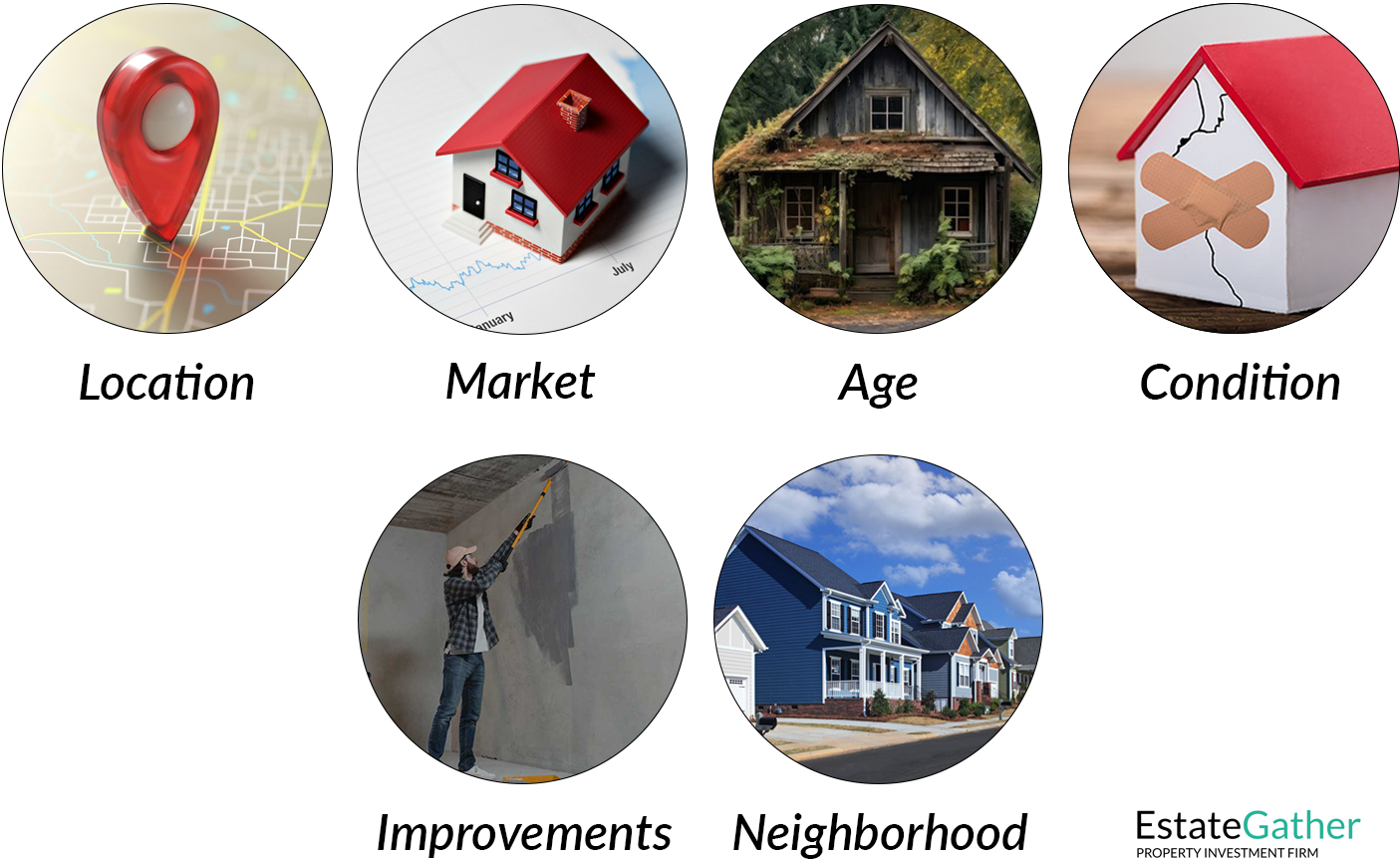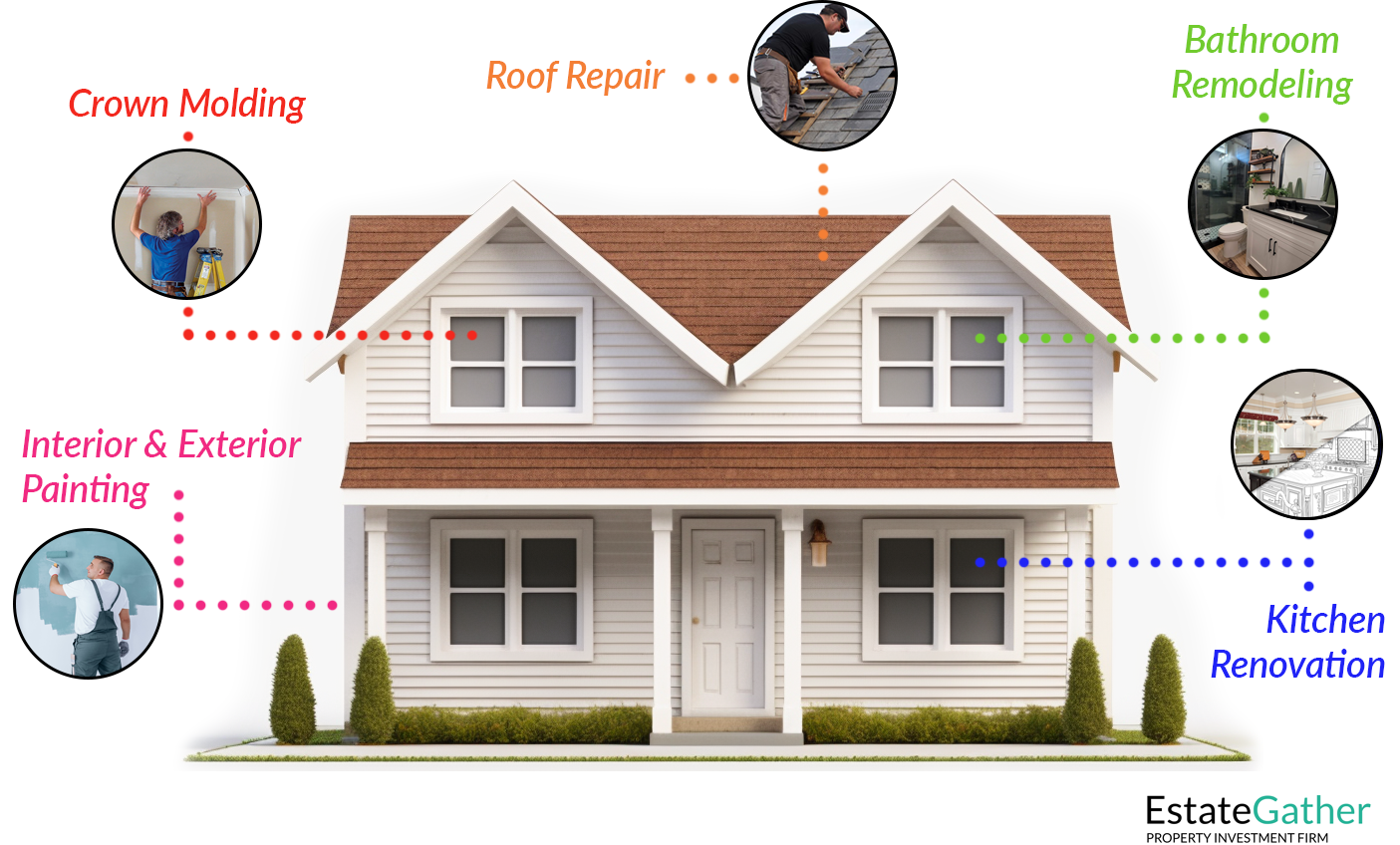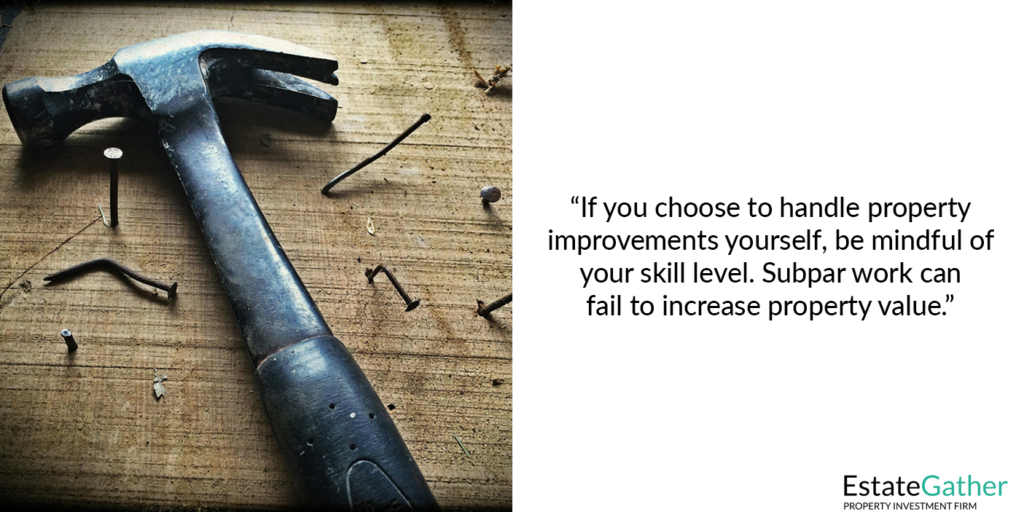
After Renovation Value

Master the art of estimating After Renovation Value (ARV) by conducting market research, professional appraisals, cost monitoring, and selecting high-ROI improvements. EstateGather’s After Renovation Value guide delivers essential takeaways, ARV calculation steps, renovation strategies, and FAQs to help you maximize your investment returns.
After Renovation Value
Renovating a property can be a rewarding endeavor, whether you’re looking to increase its resale value or simply enhance its livability. One critical aspect of this process is estimating the property’s value after renovations. Accurately gauging the post-renovation value is necessary for making informed decisions about your investment. In this guide, we’ll walk you through the steps to effectively estimate a property’s value after renovation.
KEY TAKEAWAYS
- Critical Role of Research and Analysis in Renovation: Before beginning renovations, it’s essential to research and analyze the local real estate market, including recent sales of comparable properties. Understanding current design trends, consulting with experts, and focusing on renovations that align with market demand can significantly influence the increase in a property’s value post-renovation.
- Calculating After-Repair Value (ARV) with Specific Techniques: The ARV is determined using methods like Comparative Market Analysis (CMA), which compares similar properties in the neighborhood. Factors such as sold prices, property features, location, and market trends are crucial. Accurately estimating renovation costs, including materials, labor, permits, and a contingency for unexpected expenses, is also vital.
- Impact of Specific Renovations on Property Value: Different renovations have varying effects on a property’s value. Upgrades to the kitchen and bathrooms, improvements in curb appeal, and enhancing energy efficiency are examples of renovations that can significantly increase a property’s value. It’s important to balance the cost of renovations with their potential added value.
- The Importance of Professional Appraisal and Consultation: Obtaining a professional appraisal provides a more accurate estimate of the ARV. Appraisers consider local market knowledge, renovation quality and more, providing a strong basis for negotiation. Consulting with real estate agents can also offer market insights and help identify profitable renovation options.
- Strategies for Cost Management and Value Addition: Maintaining a detailed budget, prioritizing essential renovation elements, seeking multiple quotes, and regularly reviewing budget progress are key to managing costs. Focusing on improvements that consistently add value, like kitchen and bathroom upgrades, curb appeal enhancements, and energy-efficient features, can increase the property’s value. Additionally, understanding the market’s appetite, considering future-proofing against trends, and being cautious of over-improvement are critical for maximizing ROI. Legal and zoning considerations should also be taken into account to ensure compliance and avoid potential issues.
Research and Analysis
Before you begin any renovations, be sure to conduct thorough research and analysis. Start by examining the local real estate market. Look for recent sales of comparable properties in the area that have undergone similar renovations. This will give you an idea of the potential increase in value that your renovations could bring. Our article on Valuation Techniques can assist you in this endeavor.
Additionally, delve into current design trends and preferences within the housing market. Understanding what features and styles are in high demand among potential buyers or renters can help guide your renovation decisions. You can also consult with real estate agents, interior designers, and renovation experts to gain insights into what improvements would yield the best return on investment.
Several key factors influence a property’s value, including its location, condition, age, and the surrounding neighborhood. Understanding how each of these elements contributes to After Renovation Value (ARV) is important for making smart, profitable investment decisions.
Factors That Influence Property Values

- Location affects value based on proximity to amenities, schools, job centers, and demand in the area—desirable locations typically command higher prices.
- Market conditions, including supply, demand, and broader economic trends, determine how much buyers are willing to pay at a given time.
- Age of the property can influence value depending on its construction quality, design relevance, and expected maintenance—newer homes often require fewer updates.
- Condition reflects the current state of the property; homes in poor condition may have lower initial value but greater upside after renovation.
- Improvements like modern kitchens, energy-efficient features, and updated finishes directly raise the property’s marketability and value.
- Neighborhood quality, safety, appearance, and the value of nearby homes all contribute to how a property is perceived and appraised by buyers and professionals alike.
Sponsor
YOUR
ADVERTISEMENT
HERE
Just $20 a Month, for full site coverage.

Determine the ARV
The After-Repair Value (ARV) is an estimate of a property’s value after renovations. Calculating ARV accurately is critical for making informed real estate investment decisions. The process involves four key steps: Conducting a Comparable Market Analysis (CMA), Estimating Renovation Costs, Evaluating Potential Added Value, and Finding The Price To Pay for the property you are analyzing.
Step One: Conduct a Comparable Market Analysis.
- Sold Prices: Look at recently sold properties (ideally within the last 3–6 months) that are similar in size, layout, and location.
- Property Features: Compare key attributes such as square footage, number of bedrooms and bathrooms, lot size, and amenities.
- Location: Consider factors like school districts, proximity to shopping centers, public transportation, and neighborhood desirability.
- Market Trends: Determine whether home prices are trending up, down, or remaining stable in the area.
Example Calculation:
If similar renovated homes in the neighborhood have recently sold for $250,000–$270,000, you can estimate your ARV to be around $260,000.
Step Two: Estimate Renovation Costs.
Accurate renovation cost estimates ensure your investment remains profitable. These costs should include materials, labor, permits, and a contingency fund for unexpected expenses.
- Materials: Flooring, fixtures, cabinetry, paint, appliances, etc.
- Labor: Contractor fees, electricians, plumbers, painters, and other professionals.
- Permits & Fees: Local regulations may require permits for electrical work, plumbing, or structural changes.
- Contingency Fund: A 10–20% buffer for unforeseen expenses is recommended.
Example Calculation:
If estimated renovation costs total $40,000, this amount must be factored into your ARV assessment.
Step Three: Evaluate Potential Added Value.
Not all renovations contribute equally to a property’s value. Prioritize upgrades with the highest return on investment (ROI).
- Kitchen Upgrades: Modern appliances, new countertops, and cabinetry can significantly increase home value.
- Bathroom Additions/Upgrades: Updating existing bathrooms or adding a new one enhances desirability.
- Curb Appeal Improvements: Landscaping, fresh exterior paint, and a welcoming entryway create a strong first impression.
- Energy Efficiency Upgrades: Features like upgraded insulation, windows, and energy-efficient appliances appeal to buyers.
Remember that the goal is to strike a balance between the cost of renovations and the potential added value. Some renovations might not yield a significant return, so it’s important to prioritize those that are likely to provide the best return on investment.
Renovation Ideas To Maximize Return On Investment

Step Four: Find The Price To Pay
To determine potential profit, use the 70% rule (a common guideline for real estate investors):
Max Purchase Price = (ARV × 70%) − Renovation Costs
Max Purchase Price = (260,000 × 0.7) − 40,000
= 182,000 − 40,000
=142,000
This means, to ensure a profitable investment, you shouldn’t pay more than $142,000 for the property that you will be renovating.
Seek Professional Appraisal
When determining the After-Repair Value (ARV) of a property, seeking a professional appraisal is an important step that can provide you with a more accurate estimate. While online tools and DIY research can offer general insights, a certified appraiser brings a level of expertise that’s hard to replicate. Appraisers are highly trained individuals who specialize in assessing the value of real estate properties. They take into account a multitude of factors that influence a property’s value, making their opinion highly valuable, especially in the context of real estate investing.
Here’s why seeking a professional appraisal is so important:
Negotiation Power: If you’re buying or selling a property, having an appraisal from a certified professional can provide you with a strong negotiating position. Accurate and objective appraisals provide a solid foundation for pricing discussions.
Local Market Knowledge: Appraisers have a deep understanding of the local real estate market dynamics. They are familiar with recent sales, trends, and the nuances that can impact property values in a specific area. This level of insight is challenging to acquire solely through online research.
Renovation Quality: While online tools can provide general estimates, they often lack the ability to assess the quality of renovations accurately. Appraisers are trained to evaluate the craftsmanship, materials used, and overall impact of renovations on a property’s value. This expertise ensures that the ARV calculation is based on realistic assumptions.
Unbiased Assessment: Professional appraisers are independent third parties. Their evaluation is unbiased and not influenced by personal interests. This objectivity is crucial for making informed decisions, especially when investing in real estate.
Complex Variables: The value of a property can be influenced by a range of complex variables beyond just the renovations. These include the condition of the property, its historical significance, zoning regulations, and more. Appraisers take all these factors into account to provide a comprehensive valuation.
Legal and Financing Requirements: In many cases, a professional appraisal is required for legal purposes, such as during mortgage applications or property sales. Lenders often require an independent appraisal to ensure that the property’s value supports the loan amount. Thus, a certified appraisal can help streamline financing processes.
Consult Real Estate Agents
Local real estate agents can offer insights into the market trends and buyer preferences in your area. They can provide you with information about what features and renovations are currently in demand and likely to yield higher returns. They can help you sell the renovated property too!
Sponsor
YOUR
ADVERTISEMENT
HERE
Just $20 a Month, for full site coverage.

Consider Market Appetite
A thriving market where buyers are actively seeking renovated homes can significantly influence your renovation decisions. These buyers are often willing to pay a premium for move-in-ready properties that require minimal effort on their part. Therefore, if you find yourself in such a market, investing in high-quality renovations can lead to a substantial increase in your property’s value. It’s essential to keep an eye on the preferences of these buyers, as their expectations can shape the scope and style of your renovations.
Conversely, in a slower market with limited buyer interest, you might need to approach renovations with caution. During times when properties are languishing on the market, potential buyers could be more inclined towards “fixer-upper” properties that come at a lower price point. In this scenario, over-investing in renovations might not yield the desired return on investment. It’s important to strike a balance between enhancing the property’s appeal and avoiding excessive expenses that won’t be recouped in a sluggish market.
Market trends can also play a role in determining which aspects of your property to focus on during renovation. For instance, if sustainable and energy-efficient features are highly sought after, incorporating these elements into your renovation could set your property apart and attract environmentally-conscious buyers.
To gauge the market’s appetite accurately, consider working closely with a local real estate agent who possesses a deep understanding of the current trends and demands. Their insights can help you make informed decisions about the scale and scope of your renovation project.
Future-Proofing and Trends
Consider incorporating design elements and features that have longevity and appeal. Following the latest design trends might be enticing, but it’s essential to ensure that your renovations will remain relevant for years to come.
Example Renovation Budget Allocation

Monitor Costs
Embarking on a renovation project is an exciting endeavor, but it’s crucial to keep a vigilant eye on costs throughout the process. Budget overruns can not only put a strain on your finances but also jeopardize the anticipated post-renovation value of your property. Here are some key strategies to help you effectively manage and monitor costs during your renovation journey:
- Establish a Detailed Budget: Before you start any renovation work, create a budget that outlines all anticipated expenses. This should include material costs, labor fees, permits, design fees, and a contingency fund for unexpected expenses.
- Prioritize Essential Elements: Identify the critical components of your renovation that align with your goals. Allocate a larger portion of your budget to these essential elements, such as structural improvements and high-quality materials that have a significant impact on the overall outcome.
- Obtain Multiple Quotes: When hiring contractors and service providers, don’t settle for the first quote you receive. Obtain multiple quotes to ensure that you’re getting a competitive rate for the services you need. Remember that the lowest bid isn’t always the best choice; consider the contractor’s reputation and experience as well.
- Allocate Contingency Funds: No matter how meticulously you plan, unexpected costs can arise during a renovation. Allocate a portion of your budget as a contingency fund to handle unforeseen expenses without derailing your project.
- Regular Budget Reviews: Set regular intervals to review your budget’s progress. This could be weekly, bi-weekly, or monthly, depending on the scope of the project. Use this time to compare your actual expenses against your budgeted amounts and make necessary adjustments.
- Document and Track Expenses: Keep detailed records of every expense related to your renovation. This will help you identify any discrepancies and ensure that you’re staying within your allocated budget.
- Open Communication with Contractors: Maintain open communication with your contractors and service providers throughout the renovation. Regular updates and discussions about the budget can help prevent misunderstandings and cost overruns.
- Prioritize Value Over Trends: While it’s tempting to incorporate the latest design trends, prioritize choices that offer value in the long run. Trends can change quickly, and investing in elements that stand the test of time can prevent unnecessary future renovations.
- Review Change Orders Carefully: Change orders, which involve modifications to the original project scope, can impact your budget. Review and assess each change order’s cost implications before approving them.
- Stay Flexible: While it’s essential to stick to your budget, certain situations may require flexibility. If unexpected challenges arise that could significantly impact the project’s success, be prepared to adjust your budget accordingly.
- Seek Professional Advice: If you’re uncertain about budget management, consider consulting a financial advisor or a professional experienced in renovation project management. They can provide valuable insights and guidance to help you navigate the financial aspects of your renovation.
- Regularly Assess Progress: As the renovation progresses, assess the quality of the work being done. Poor craftsmanship or shortcuts taken to cut costs could lead to larger expenses down the line. Address any concerns promptly.
Calculate Return on Investment (ROI)
Understanding the potential Return on Investment (ROI) allows for assessing the profitability of your renovations. ROI is calculated by dividing the net profit (after deducting renovation costs) by the total investment (including renovation costs). A higher ROI indicates a more favorable investment.
Sponsor
YOUR
ADVERTISEMENT
HERE
Just $20 a Month, for full site coverage.

Improvements that Add Value
When it comes to increasing a property’s value, certain renovations consistently stand out as high-impact investments. These improvements not only enhance the property’s appeal but also offer a strong return on investment. Here’s a detailed look at the most valuable upgrades:
- Kitchen Upgrades: The kitchen is often regarded as the centerpiece of the home, and its condition can significantly influence a property’s value. Upgrading to modern, energy-efficient appliances, installing durable and attractive countertops like granite or quartz, and updating cabinets with sleek designs can transform the kitchen into a selling point. Enhanced lighting, including under-cabinet lights and stylish fixtures, can further elevate the space. A well-designed kitchen can make the home feel more inviting and functional, making it a top priority for potential buyers.
- Bathroom Additions or Upgrades: Bathrooms are another critical area where renovations can yield substantial value. Adding an extra bathroom, especially in homes with limited existing bathrooms, can significantly increase a property’s desirability. For existing bathrooms, upgrading with modern fixtures, such as dual sinks, frameless glass showers, or soaking tubs, can create a spa-like experience that appeals to buyers. High-quality tiles, energy-efficient toilets, and contemporary finishes contribute to a bathroom that feels luxurious and up-to-date.
- Curb Appeal Enhancements: The exterior of a property is the first thing potential buyers see, making curb appeal a vital aspect of property value. Simple improvements like a fresh coat of paint, new siding, or updated windows can give the home a polished look. Landscaping upgrades, such as adding colorful plants, maintaining a healthy lawn, or installing outdoor lighting, can create an inviting atmosphere. Features like a new front door or a renovated driveway can also contribute to a positive first impression, making the property more attractive from the outset.
- Energy-Efficient Features: As sustainability becomes increasingly important to buyers, energy-efficient upgrades have become highly valuable. Installing solar panels can reduce electricity costs and appeal to environmentally conscious buyers. Upgrading insulation in walls and attics can improve energy efficiency and comfort, while energy-efficient windows can reduce heating and cooling costs. These features not only make a home more eco-friendly but also lower long-term utility bills, which can be a significant selling point.
- Open Floor Plans: Modern buyers often seek open, spacious living areas that allow for flexibility and social interaction. Removing non-structural walls to create open-concept spaces can make a property feel larger and more cohesive. This layout is particularly appealing in common areas like the kitchen, dining, and living rooms, where it fosters a sense of connection and fluidity. An open floor plan can also improve natural light flow throughout the home, enhancing its overall ambiance and making it more attractive to prospective buyers.
Do It Yourself, OR Professional Renovations
While DIY projects can save money, it’s essential to recognize your limits and ensure that the quality of the renovations remains high. Subpar work can actually decrease the property’s value. For more complex tasks or those requiring specialized skills, it’s often wiser to hire professionals to ensure a polished result.

Over-Improvement Caution
While renovations can boost a property’s value, it’s important not to over-improve. Investing in high-end finishes and features that greatly exceed the norm in your neighborhood may not necessarily translate into a proportionate increase in value. Strive for a balance between the quality of renovations and the surrounding properties.
Legal and Zoning Considerations
Before undertaking any renovations, ensure that you are aware of local zoning regulations, building codes, and permits required for the changes you’re planning. Failure to adhere to these requirements can lead to costly legal and financial repercussions.
Market Timing
The timing of your property’s sale can impact its post-renovation value. Market conditions can fluctuate throughout the year, and selling during a peak season when demand is high can lead to a better sale price.
Market Perception and Emotional Appeal
The emotional appeal of a property can significantly impact its perceived value. A well-staged and beautifully presented property can evoke positive emotions in potential buyers, leading them to perceive higher value. Invest in staging and presentation to maximize your property’s appeal.
Conclusion
Estimating a property’s ARV is a complex task that requires a combination of research, professional insight, and strategic decision-making. By carefully considering factors like market trends, renovation choices, timing, and professional expertise, you can make informed decisions that not only enhance your property’s value but also align with your investment goals. Remember that while the estimation process is crucial, the final outcome will ultimately depend on the dynamic interplay between your property’s features, market conditions, and buyer preferences.
Frequently Asked Questions (FAQ)
What is ARV in real estate?
ARV, or After Repair Value, is an estimate of a property’s value after all planned renovations and repairs are completed. It is a critical figure for real estate investors, particularly those involved in flipping properties, as it helps determine the potential profit margin.
How do you calculate ARV?
To calculate ARV, you start with a base property value typically derived from a Comparative Market Analysis (CMA) that assesses similar, recently sold properties in the area. Then, add the value you expect to add through renovations. This total gives you the ARV.
What is a Comparative Market Analysis (CMA)?
A Comparative Market Analysis is a tool used by real estate professionals to estimate a home’s value based on the sales prices of similar properties in the same area. For ARV calculations, it involves analyzing properties of similar size, location, and condition that have recently sold, adjusting their prices based on the differences in features and conditions to estimate the post-renovation value of a property.
Which renovations add the most value to a property?
The renovations that typically add the most value to a property include updating kitchens and bathrooms, adding square footage (such as finishing a basement or adding a room), enhancing curb appeal, and upgrading home systems to modern, energy-efficient versions.
Should I always aim for the highest possible ARV?
While a higher ARV can potentially increase profits, it’s important to balance the cost of renovations against the realistic sale price in the local market. Over-improving a property beyond the standards of the neighborhood might not yield a proportionate return on investment.
What are some common mistakes in calculating ARV?
Common mistakes include underestimating renovation costs, overestimating the added value of renovations, ignoring market trends, and neglecting necessary repairs that don’t directly add value but are crucial for the sale.
How can I ensure my ARV estimate is accurate?
To ensure accuracy, perform thorough market research, consult with multiple professionals, keep a detailed and realistic budget for renovations, and regularly reassess the budget and market conditions during the renovation process.
What role does market trend play in estimating ARV?
Market trends play a significant role as they influence the overall demand and pricing in the real estate market. A rising market may enhance ARV, while a declining market might limit the potential sale price regardless of improvements made.
Can changes in interest rates affect ARV?
Yes, changes in interest rates can affect ARV by influencing buyer affordability. Lower interest rates generally increase buyer purchasing power and demand, potentially raising property values, while higher rates may decrease demand and suppress property prices.
What is the best strategy for maximizing ARV on a limited budget?
The best strategy is to focus on cosmetic improvements that offer high returns at lower costs, such as painting, minor kitchen and bathroom updates, and enhancing curb appeal. Also, prioritize repairs and upgrades that address critical structural or functional issues, as these can deter buyers if left unaddressed.

